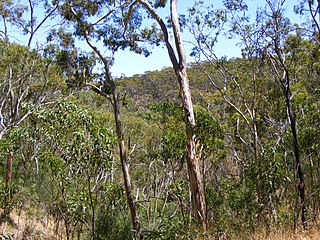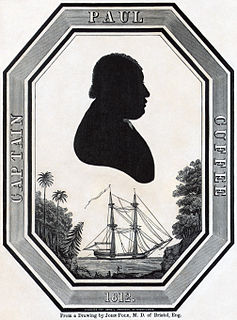Related Research Articles

Sierra Leone, officially the Republic of Sierra Leone, informally Salone, is a country on the southwest coast of West Africa. It is bordered by Liberia to the southeast and Guinea to the northeast. Sierra Leone has a tropical climate with a diverse environment ranging from savanna to rainforests, a total area of 71,740 km2 (27,699 sq mi) and a population of 7,092,113 as of the 2015 census. The capital and largest city is Freetown. The country is divided into five administrative regions which are subdivided into sixteen districts.. Sierra Leone is a constitutional Republic with a unicameral parliament, and a directly elected president.
Sierra Leone first became inhabited by indigenous African peoples at least 2,500 years ago.The Limba were the first tribe known to inhabit Sierra Leone. The dense tropical rainforest partially isolated the region from other West African cultures, and it became a refuge for peoples escaping violence and jihads. Sierra Leone was named by Portuguese explorer Pedro de Sintra, who mapped the region in 1462. The Freetown estuary provided a good natural harbour for ships to shelter and replenish drinking water, and gained more international attention as coastal and trans-Atlantic trade supplanted trans-Saharan trade.

Freetown is the capital and largest city of Sierra Leone. It is a major port city on the Atlantic Ocean and is located in the Western Area of the country. Freetown is Sierra Leone's major urban, economic, financial, cultural, educational and political centre, as it is the seat of the Government of Sierra Leone. The population of Freetown was 1,055,964 at the 2015 census.

Belair National Park is a protected area in Belair, South Australia, 13 kilometres south of Adelaide city centre; it covers an area of 835 hectares. It was proclaimed in 1891 and was the first national park in South Australia, second in Australia and the tenth in the world. The national park lies within the Adelaide Hills and Mitcham council area, and forms part of a chain of protected areas located along the Adelaide Hills Face Zone. The national park is administered by the Department of Environment, Water and Natural Resources.

Siaka Probyn Stevens was the leader of Sierra Leone from 1967 to 1985, serving as Prime Minister from 1967 to 1971 and as President from 1971 to 1985. Stevens' leadership was often characterized by patrimonial rule and self-indulgence, consolidating power by means of corruption and exploitation.

The Sierra Leone Civil War (1991–2002) was a civil war in Sierra Leone that began on 23 March 1991 when the Revolutionary United Front (RUF), with support from the special forces of Charles Taylor’s National Patriotic Front of Liberia (NPFL), intervened in Sierra Leone in an attempt to overthrow the Joseph Momoh government. The resulting civil war lasted 11 years, enveloped the country, and left over 50,000 dead.
Sir Albert Michael Margai was the second prime minister of Sierra Leone and the half-brother of Sir Milton Margai, the country's first Prime Minister. He is also the father of Sierra Leonean politician Charles Margai.

Paul Cuffe, also known as Paul Cuffee was an American businessman, whaler and abolitionist. Born free into a multiracial family on Cuttyhunk Island, Massachusetts, Cuffe became a successful merchant and sea captain. His mother, Ruth Moses, was a Wampanoag from Harwich, Cape Cod and his father an Ashanti captured as a child in West Africa and sold into slavery in Newport about 1720. In the mid-1740s, his father was manumitted by his Quaker owner, John Slocum. His parents married in 1747 in Dartmouth.

Parliament of Sierra Leone is the legislative branch of the government of Sierra Leone. It is principally responsible for making laws. The Sierra Leone parliament consists of 146 members, of which 132 members are directly elected from across Sierra Leone's 16 districts, while 14 are paramount chiefs appointed from the 14 rural districts. The parliament is led by the Speaker of the House; the position is currently held by Abass Bundu of the Sierra Leone People's Party. The current elected 132 ordinary members of parliament are composed of members of the All People's Congress, the Sierra Leone People's Party which are the two largest political parties in Sierra Leone plus two other parties, the National Grand Coalition and the Coalition for Change and finally, three Independent members who were not elected under any party.
Thomas Peters, born Thomas Potters, was a veteran of the Black Pioneers, fighting for the British in the American Revolutionary War. A Black Loyalist, he was resettled in Nova Scotia, where he became a politician and one of the "Founding Fathers" of the nation of Sierra Leone in West Africa. Peters was among a group of influential Black Canadians who pressed the Crown to fulfill its commitment for land grants in Nova Scotia. Later they recruited African-American settlers in Nova Scotia for the colonisation of Sierra Leone in the late eighteenth century.
Jamaican Maroons descend from maroons, Africans who escaped from slavery on the Colony of Jamaica and established free communities in the mountainous interior, primarily in the eastern parishes. Escaped Africans who were enslaved during Spanish rule over Jamaica (1493–1656) may have been the first to develop such refugee communities.
Harry Washington was known as a slave of Virginia planter George Washington, later the first President of the United States. He served as a Black Loyalist in the American Revolutionary War when the war was lost the British then evacuated him to Nova Scotia. In 1792 he joined nearly 1200 freedmen for resettlement in Sierra Leone, where they set up a colony of free people of color.
Maroon Town, Sierra Leone, is a district in the settlement of Freetown, a colony founded in West Africa by Great Britain.
The Jamaican Maroons in Sierra Leone were a group of just under 600 Jamaican Maroons from Cudjoe's Town, the largest of the five maroon towns in Jamaica, who were deported by British forces following the Second Maroon War in 1796, first to Nova Scotia. Four years later in 1800, they were transported to Sierra Leone.
George William Nicol (1810-1884) was the first African Colonial Secretary of Sierra Leone and was one of few African senior level colonial officials in Freetown during the 19th century. Nicol belonged to the mulatto Settler class that exerted great influence in Freetown during the 19th century.

Sierra Leone was a sovereign state with Queen Elizabeth II as its head of state between independence on 27 April 1961 and becoming the Republic of Sierra Leone on 19 April 1971.

The Sierra Leone National Museum is the national museum of Sierra Leone. The museum is located at the junction of Siaka Stevens Street and Pademba Road in central Freetown, the capital of the country.
Charles William Maxwell Heddle was a Scottish-Sierra Leonian businessman and shipowner. In 1870 he retired to France where he died in 1889.
References
- ↑ Alldridge, Thomas J. (1910). A Transformed Colony, Sierra Leone, as it Was, and as it Is, Its Progress, Peoples, Native Customs, and Undeveloped Wealth. London, United Kingdom: Seeley and Co. Limited.
- ↑ "SierraLeoneHeritage.org | National Monuments | Heddles Farm". www.sierraleoneheritage.org. SierraLeoneHeritage.org. Retrieved 29 July 2017.
| This Sierra Leonean history-related article is a stub. You can help Wikipedia by expanding it. |